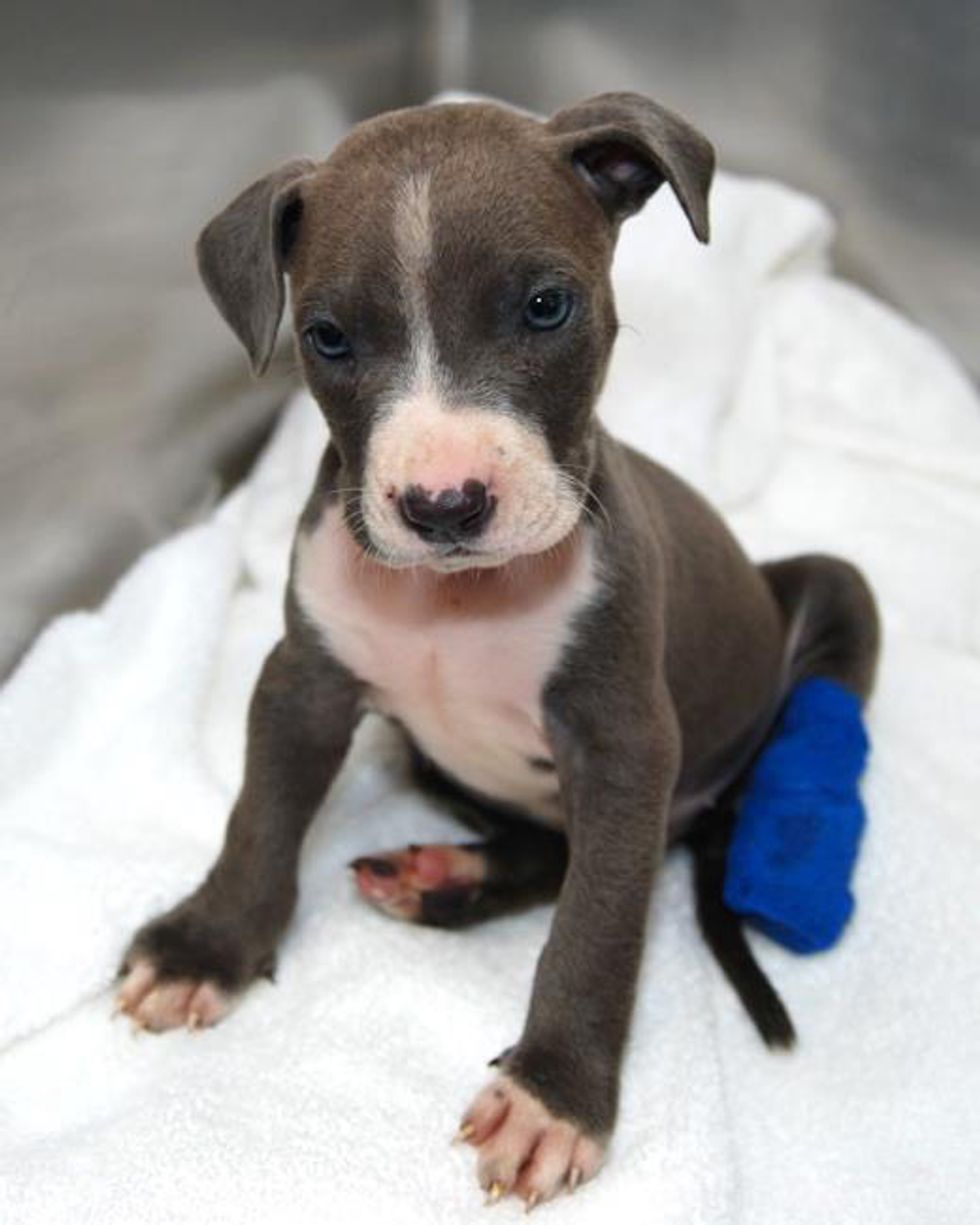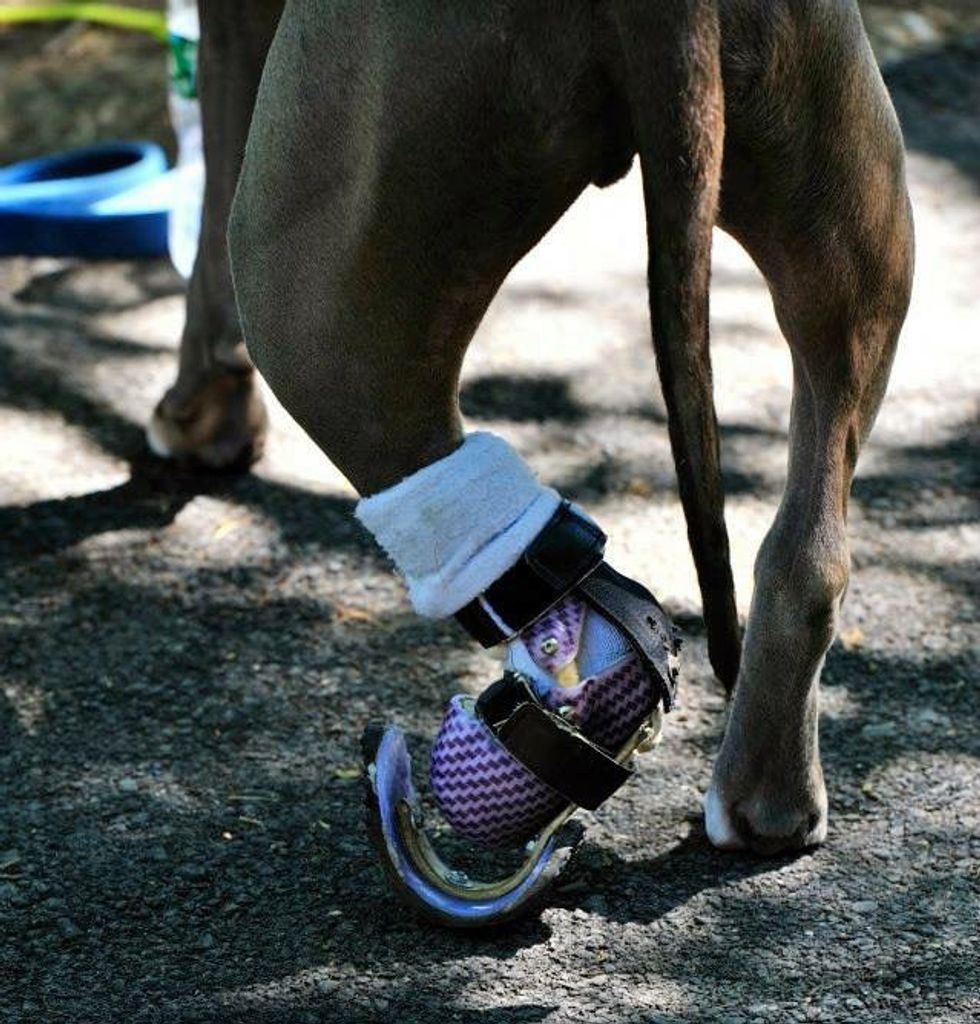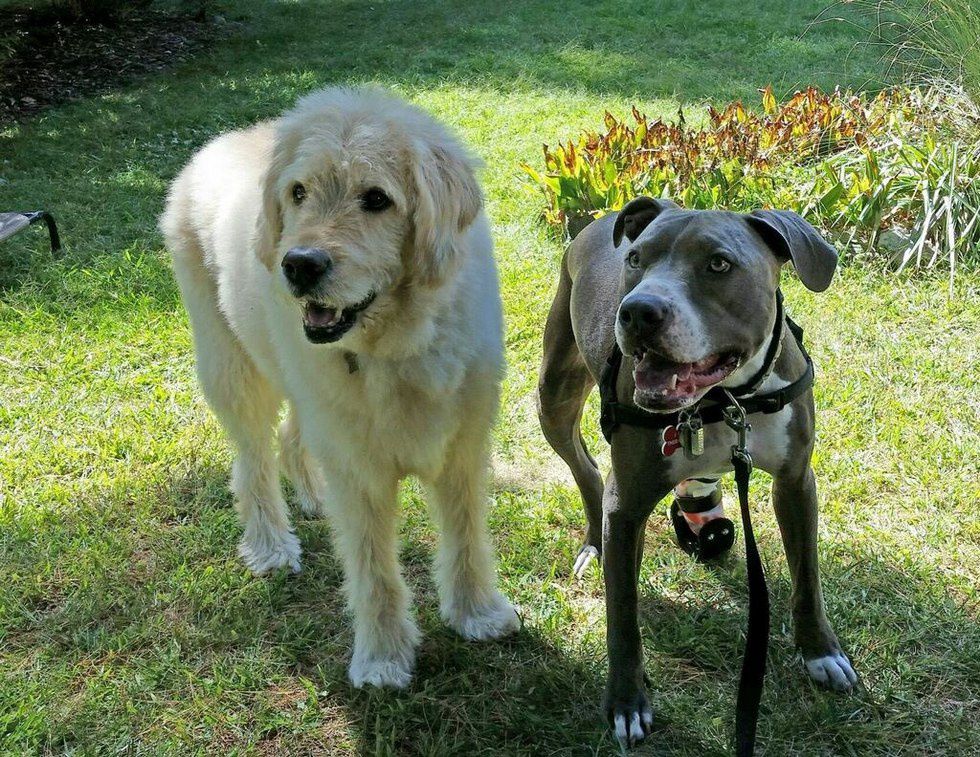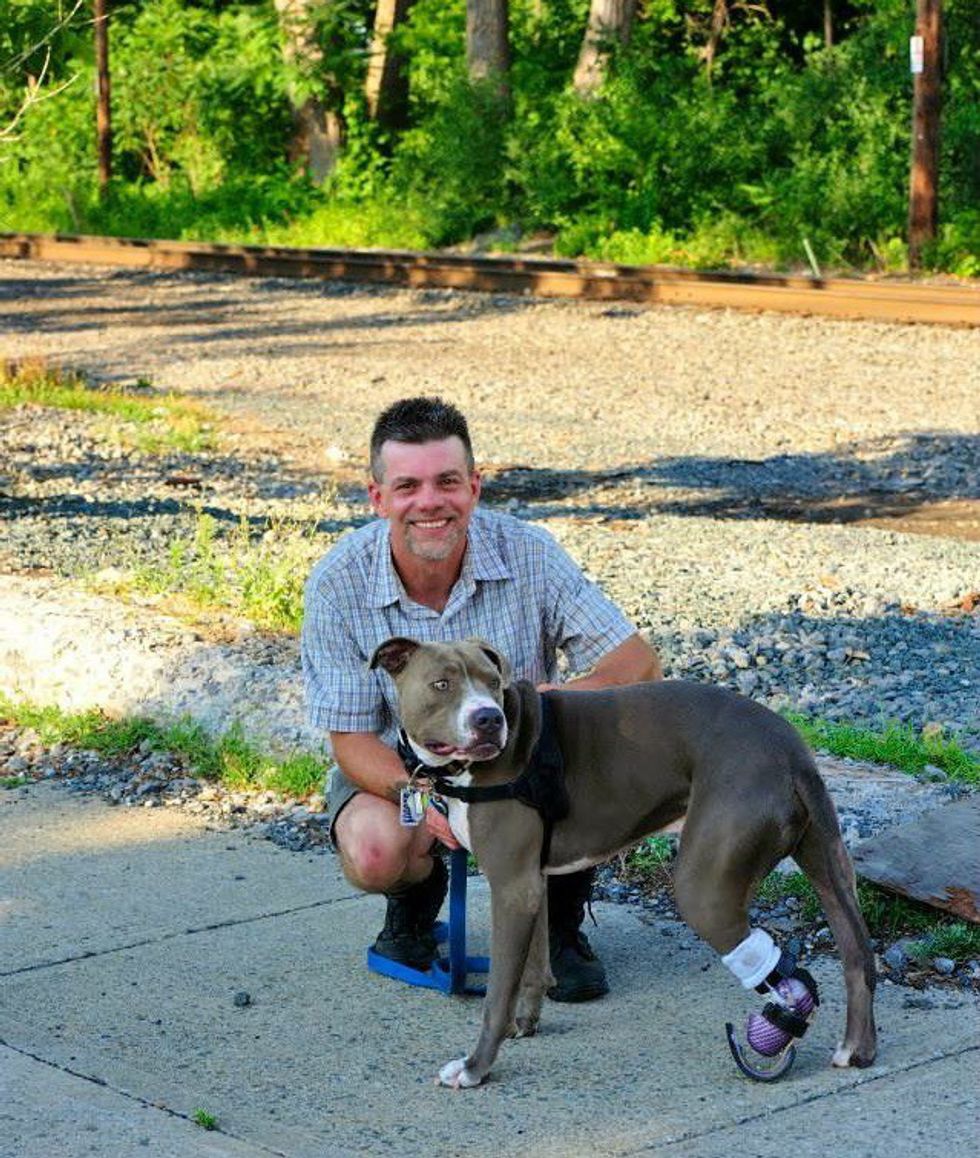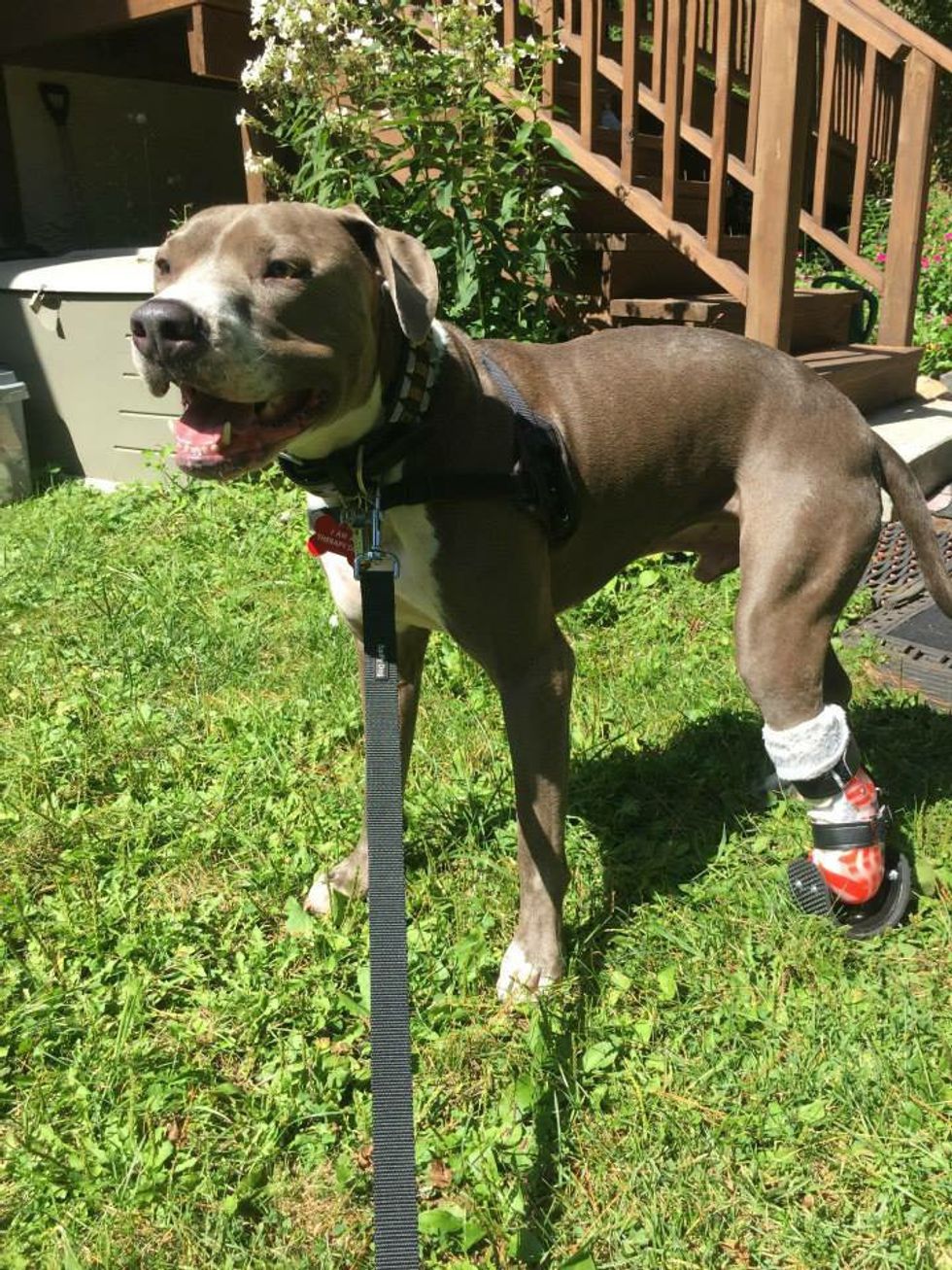In 2012, in Albany, NY railroad workers found three 3-week-old blue nose pit bull mix puppies nailed to railroad tracks on the Hudson and Mohawk rail line near North Pearl Street. All of the puppies were malnourished and had infections. One puppy died soon after she was found. The others puppies were named for the streets near which they were found: Hudson and Pearl.
Hudson’s back paw had been cut off and was so badly injured that it had to be amputated. It was one of the worst cases of animal cruelty ever seen in Upstate New York. Hudson was in such bad shape, they weren’t even sure he would survive the short ride to the Mohawk Hudson Humane Society where the pups were taken for care.
The puppies came to be known as the “railroad puppies” and the horrific nature of the abuse case attracted intense media attention.
After multiple surgeries, Hudson became one of the first dogs in New York State to be fitted with a prosthetic paw.
The shelter was inundated with calls from people who wanted to adopt Hudson. When the shelter decided to require interested people to write an essay explaining why they should be considered, they received hundreds of essays, including one from Richard and Rosemarie Nash.
“We knew we could give him a really good life,” said Richard Nash. “I worked for myself and my wife works from home. We could take him to doctors and do media and be there for him in every possible way. So we wrote our essay and soon after, we learned we had been chosen to do a meet and greet with Hudson. We brought our dog, Sami, with us to the shelter and it was like they were brother and sister.”
By this time, Hudson was about 4 months old.
Hudson was able to walk on his stump and had a prosthetic, but it was not a good fit for him. Hudson’s surgeon, Dr. Tom Bowersox, reached out to Derrick Campana, who had not intended create a new career for himself back in 2005 when he started Animal Ortho Careto create prosthetics and orthotics for dogs, cats, and other animals. Hewas a technician building prosthetic and orthotic devices for people at Hanger Orthopedic Group. One day a vet brought his dog into the office to see if Campana could create a prosthetic device for a congenital deformity of the dog’s paw, which looked like a lobster claw.
“I had never made such a device, but was up for the challenge. I successfully fabricated a prosthesis and the dog was able to walk much better with it. The vet said no one was really doing this type of thing for animals. At that moment, a light bulb went off and I thought to start a new business,” said Campana, who knew he would able to apply principles from people to animals. “I thought it would be a great way to combine my experience and my love of animals.”
Campana’s company is one of a few practices in the world that cater specifically to the needs of animals. (There are only 10 people in the world who make prosthetics for animals.) His clients include dogs, cats, horses, camels, cows, goats, lizards … and even an elephant. His patients are either born with a congenital defect or have issues due to old age, an accident, or abuse.
Campana was touched by Hudson’s story and got right to work.
“The best part is watching animals walk again, sometimes for the first time,” said Campana. “The look in their eyes and seeing them wag their tail – especially with the more traumatic cases – that’s just great, but unfortunately, we see a lot of cruelty cases.”
Dr. Bowersox took a cast of Hudson’s stump. Campana created several prototypes. A few months later Campana traveled to Albany to fit Hudson with his final prosthetic.
“When Hudson received his prosthetic, the change in him was instant. Before he did not trust people,” said Nash. “After the cruelty he had experienced, I knew something had to change for him. The prosthetic gave him a lot more self-confidence. He got up and was running for the first time. He was like a normal dog playing. It was instant, like a light switch. He got up and started running and playing like he had a paw. He knew.”
Hudson has different prostheses, but uses one called the “bladerunner” most often.
“Campana sends different prototypes of prosthetics to Hudson to test out to keep improving them for future patients,” said Nash.
Today Hudson is 4-years-old and his life is anything but sad and tragic. He is a therapy dog and visits schools, nursing homes adult day care facilities, hospice centers, and hospitals.
“People see how he has persevered and overcome the evilness that was done to him. He’s become a great and loving dog,” said Nash.
In 2015, Hudson was honored as a hero by the American Humane Association at its annual Hero Dog Awards ceremony in Los Angeles. He won the award for his work as a therapy dog and spreading awareness about animal cruelty.
“Hudson is teaching people that just because you are different does not meet you are not special,” said Nash. “People may have a walker or leg brace or artificial limb and they can relate to him. They are comforted by him.”
Hudson is also changing hearts and minds about the pit bull breed one at a time,” said Nash. “People have said that before they met Hudson they were afraid of pit bulls.”
“He’s one of the laziest dogs I know. So laid back and likes to chill out. He likes to sleep and eat and play. He lets you love on him. That’s what makes him a great therapy dog,” said Nash.
When asked what advice he has for people considering adopting a dog that uses or needs a prosthetic device, Nash said, “Just do it. The animals with special needs are the most amazing and loving in the world. There are resources and people who can help. No one should be afraid of adopting a differently-abled animal. Just like any other animal.”
Nash is in the process of forming a nonprofit called Huddy’s Buddy so he can help other dogs get medical devices for a better quality of life. Hudson even has his own Instagram, Twitter, and Facebook accounts.




